How To Deal With A Wet Chicken Run
If you have ever dealt with a messy chicken coop run, you know what a headache it can be. Puddles of water, deep, thick mud, and no drainage can make it all a huge nasty mess. This post will give you our best tips on how to deal with a wet chicken run.
Raising chickens is a great way to start raising livestock on your homestead, but it can also come with a few headaches. ; keep a dry run so you have a healthy laying flock.
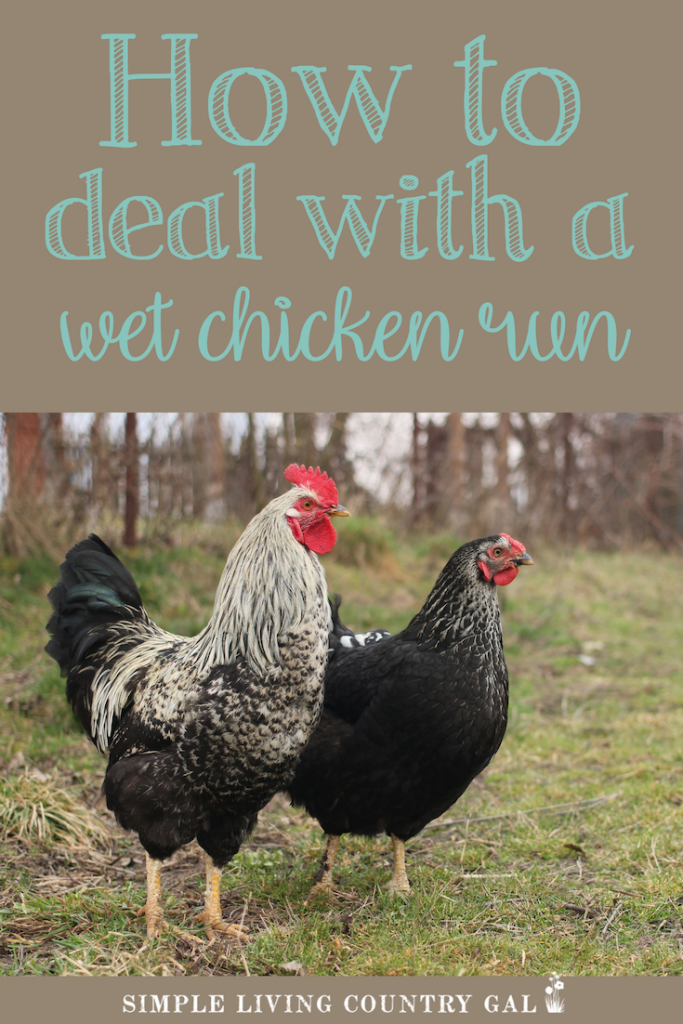
If you have been raising chickens, you already know what a fun and quirky animal they are. I love watching my flock chatter and cluck as they make their way around the yard. Chickens are self-sufficient animals, meaning if you provide them with the basics, food, water, and shelter, they can take care of the rest.
Chickens also have a few habits that can cause negative effects on a coop and run. One of them being scratching.
What do chickens eat when they scratch the ground?
When chickens scratch the ground, they are raking at the soil with their clawed feet. This helps uncover any worms, bugs, and slugs they enjoy eating. The good news is that chickens can reduce the number of pests in your lawn and garden.
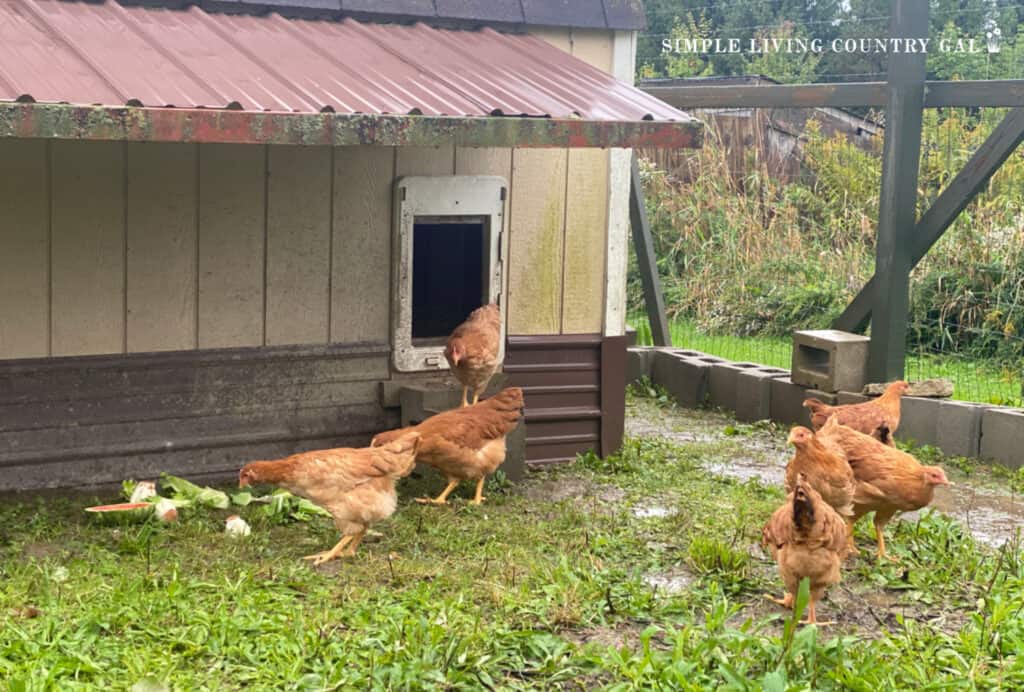
The bad news is that scratching can transform a grassy area into a pile of dirt in no time. And that dirt pile, in turn, can become a plot of mud with just one rainfall. Our chicken run is one of the worst places on our homestead, especially in the springtime.
There is just no way around it. When the snow melts, and the spring rains arrive, all that water sits in the chicken run area, forming puddles and mud. We know we desperately need drainage, but it is buried at the bottom of our to-do list, so I don’t expect it to get done anytime soon.
And since we can’t put in drainage, I have learned a few things we can do to alleviate the condition of our chicken run, helping our flock to have a dryer area that they can access during the day.
Please note that I live in Northwestern, PA, so my tips may not work for you if you live in a much wetter climate. Also, these tips are meant to be a temporary fix, and if your area is prone to heavy rains, you will want to find a more permanent solution, such as the drainage I mentioned above.
How to Deal With a Wet Chicken Run
A wet and muddy chicken run is a concern in the warmer months, but it is even more so in the colder months. If you are not careful, chickens can get frostbite on their combs and wattles, so it is important to ensure you have a shelter for them year-round.
If you are new to chickens and do not have a coop yet, you can purchase a coop, get coop plans online so you can build your own, or transform an old shed into a chicken coop as we did.
Although uncommon, chickens can get frostbite on their feet, so it is important to have a dry and warm place for them to stand in any weather.
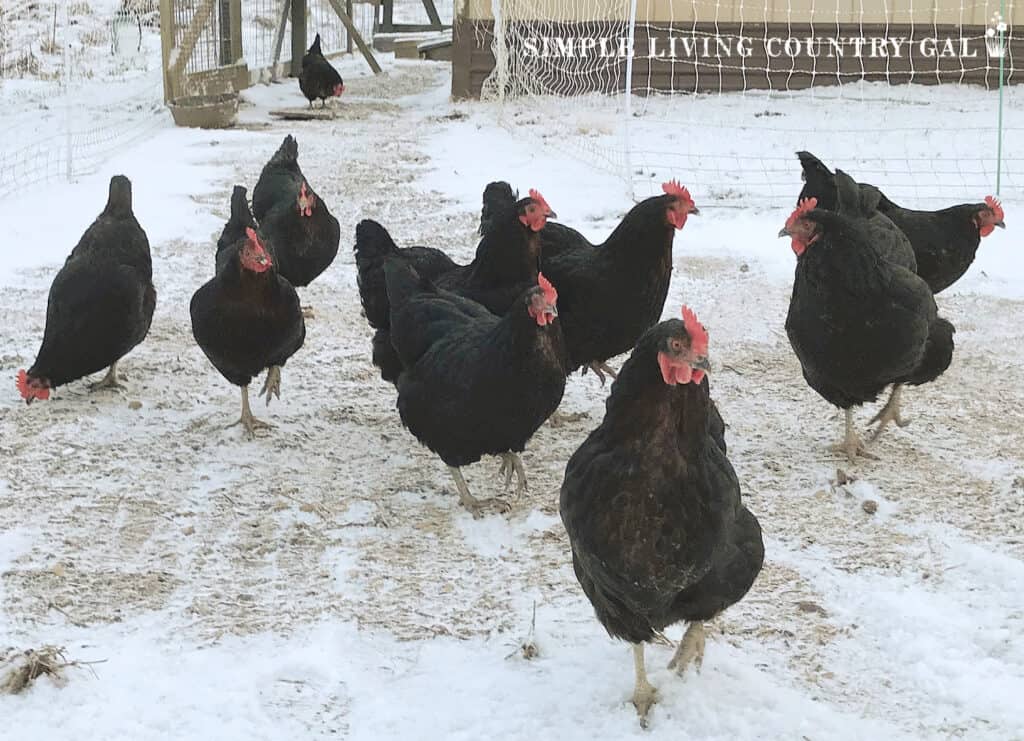
Option #1. Lay down a barrier
If you have other livestock that eat hay, you can use that to provide a temporary barrier. We do this with discarded hay our goats drop as they are eating. Rather than toss the hay into our compost pile we will use it in the chicken run.
The hay provides a temporary dry surface for the hens in the run, keeping them and the inside coop much cleaner. No, it is not the best fix, but it will get you by in a pinch until you can do more permanent solutions.
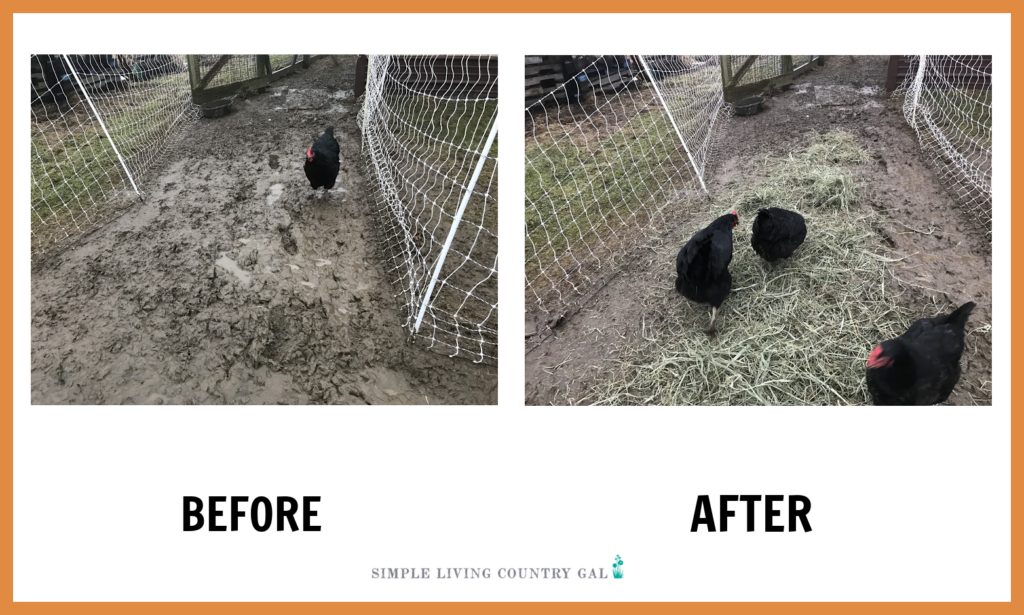
Another tip is to put in a bale of straw and let your chickens do the work.
They will peck at the straw, throwing it around and covering the muddy areas in the run. This will give them something to do and help alleviate the mess in the run at the same time.
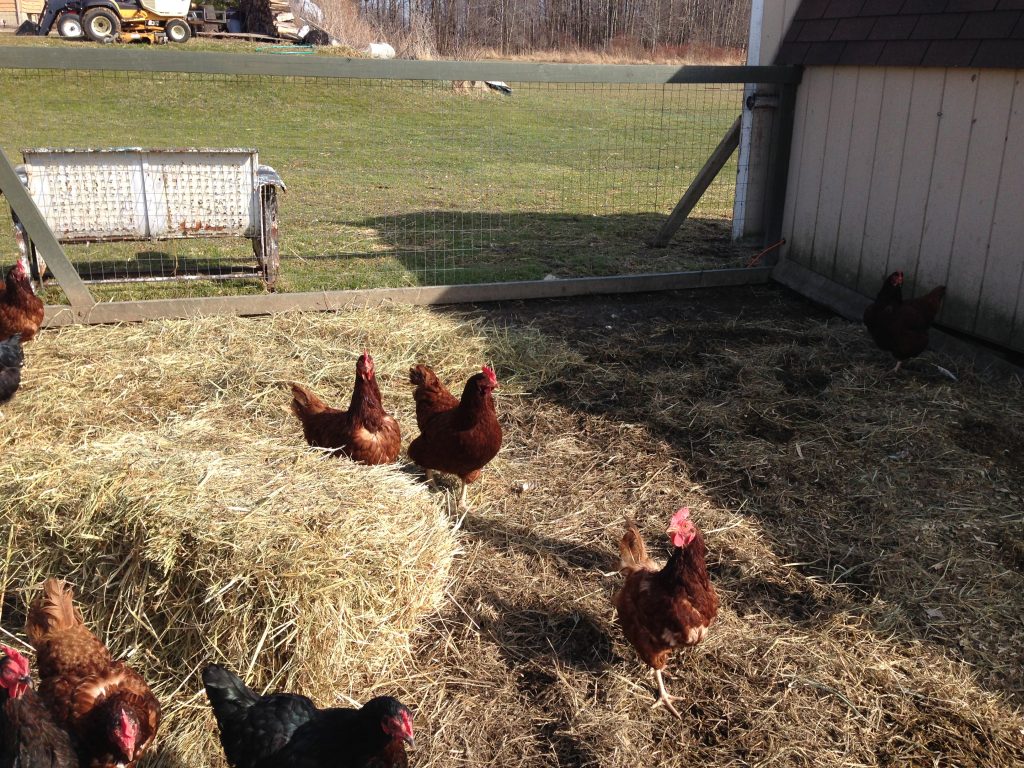
The cons of using hay in the run
The downside of using hay or straw is that you will need to remove it later. We usually do a run clean out each spring, removing the top layer of soil. In that layer is any hay or straw we added over the winter, along with chicken manure.
- You will need a wheelbarrow, pitchfork, and, hopefully, a willing child to help. It is pretty thick at this point (about 4-8 inches), and no, it’s not an easy task, so having help is beneficial.
- Using a shovel, scrape off the top layer of material.
- You can add this to your compost pile; it is a great layer to have and will compost down nicely, so you can use it in your garden.
- Once the top layer is removed, you may find the soil beneath is hard and compacted. You can break things up with a shovel, a pick axe, or a rototiller for a much easier job.
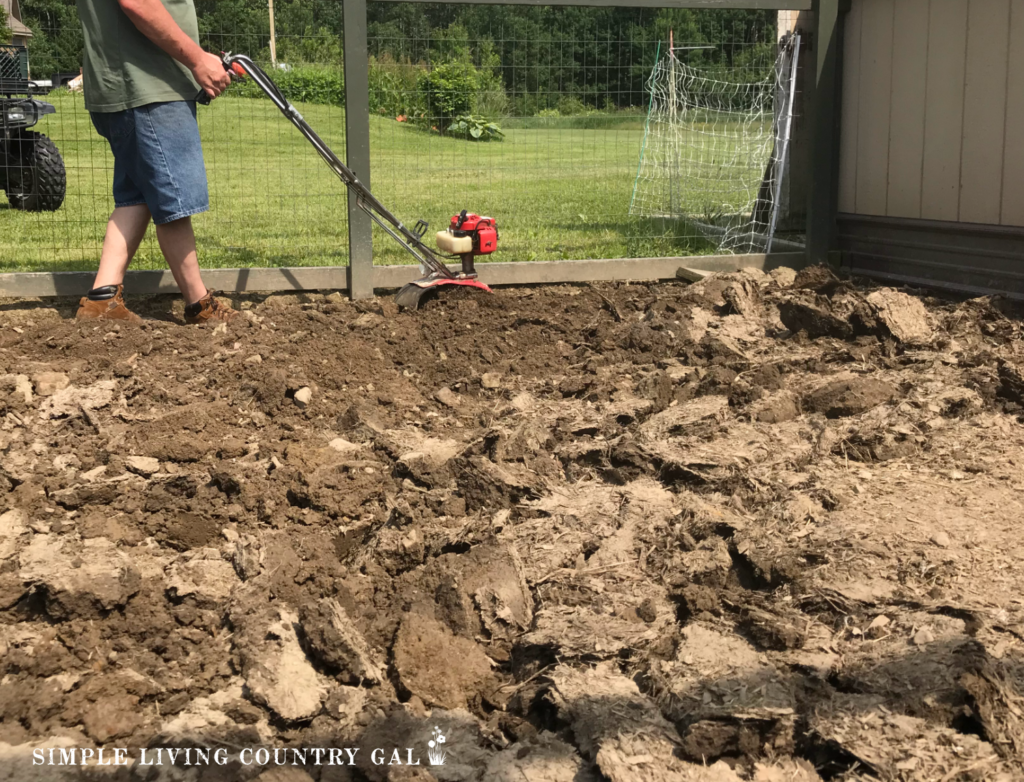
what else can you lay down in a wet run?
We like to use hay or straw in our chicken run but if you do not have those materials available to use, there are a few more options that will work.
Grass Clippings
Because of the moisture content in fresh-cut grass, it is not the best solution, but it will do a good enough job to get you through.
My chickens LOVE grass clippings. There are usually many bugs found mixed in with the cut grass, so the chickens will spend time looking for treats. Cut grass is a great boredom buster for hens any time of year.
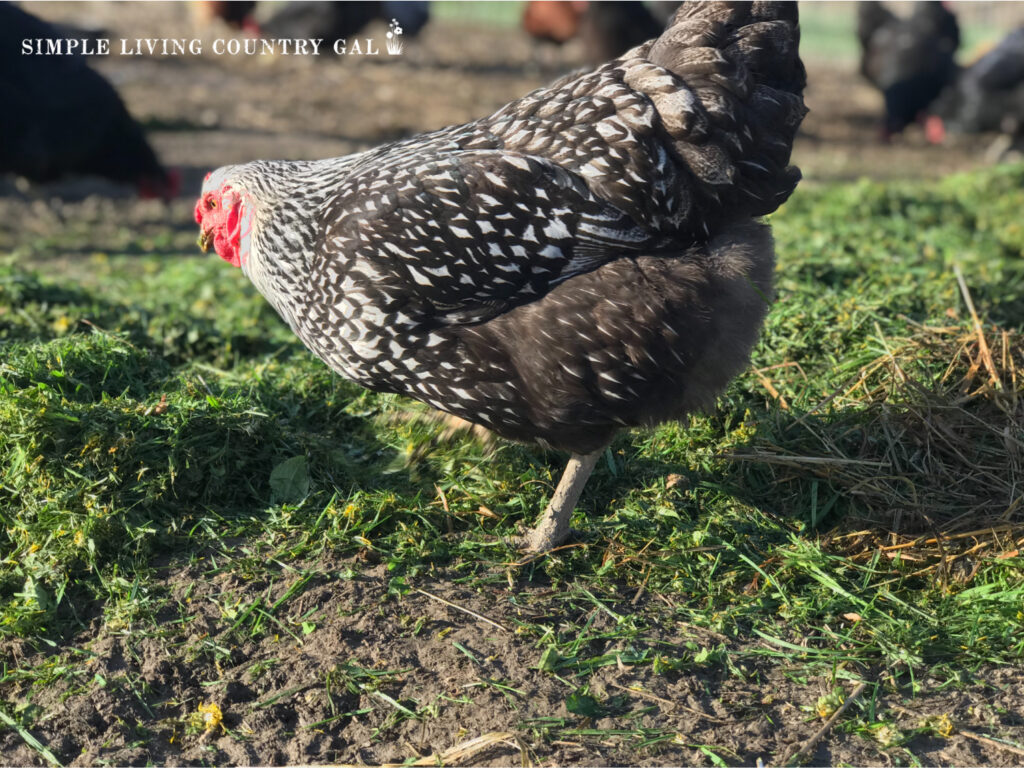
Dry Leaves
If it’s fall, dry leaves will work well and are another favorite of chickens. There can be quite a few bugs in those leaves, and chickens love their bugs.
Again, your goal is to put your focus where the worst of the mud is; usually, this ends up being the main path in your coop. Drop-in piles of leaves to give a dryer spot for them to stand.
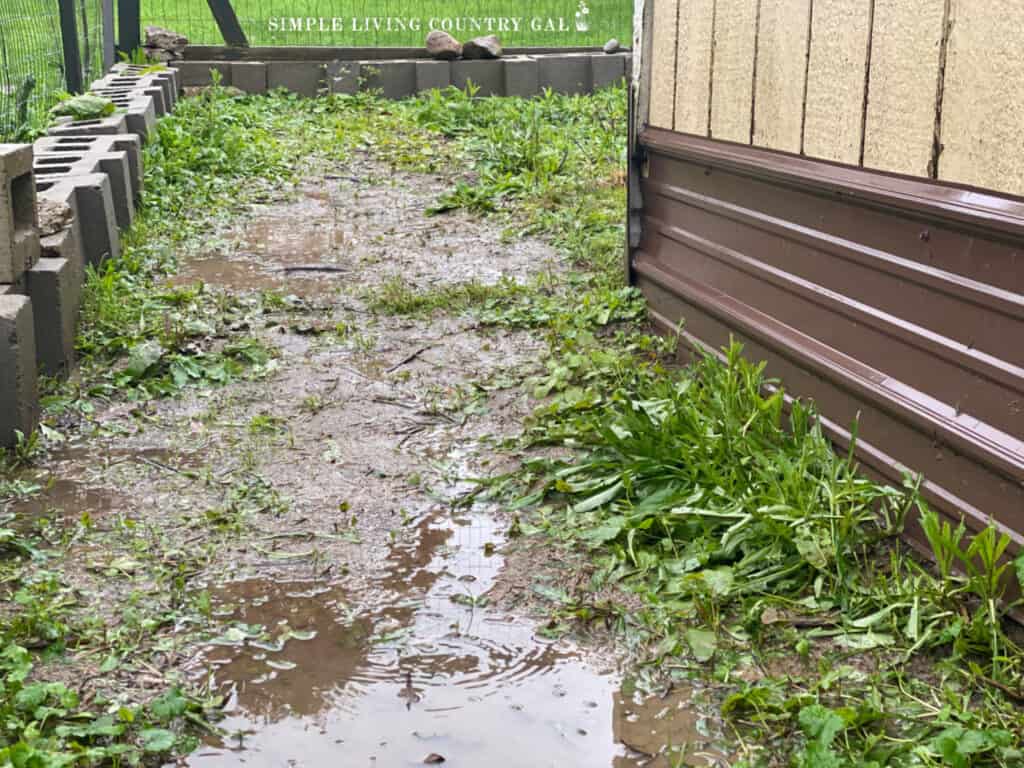
SAwdust or wood shavings
Another option is sawdust or wood shavings. If you cut wood to heat your home, you may have a pile of materials that you can use in your chicken run. Sawdust, wood chips, and even pieces of bark will all work great in a muddy run.
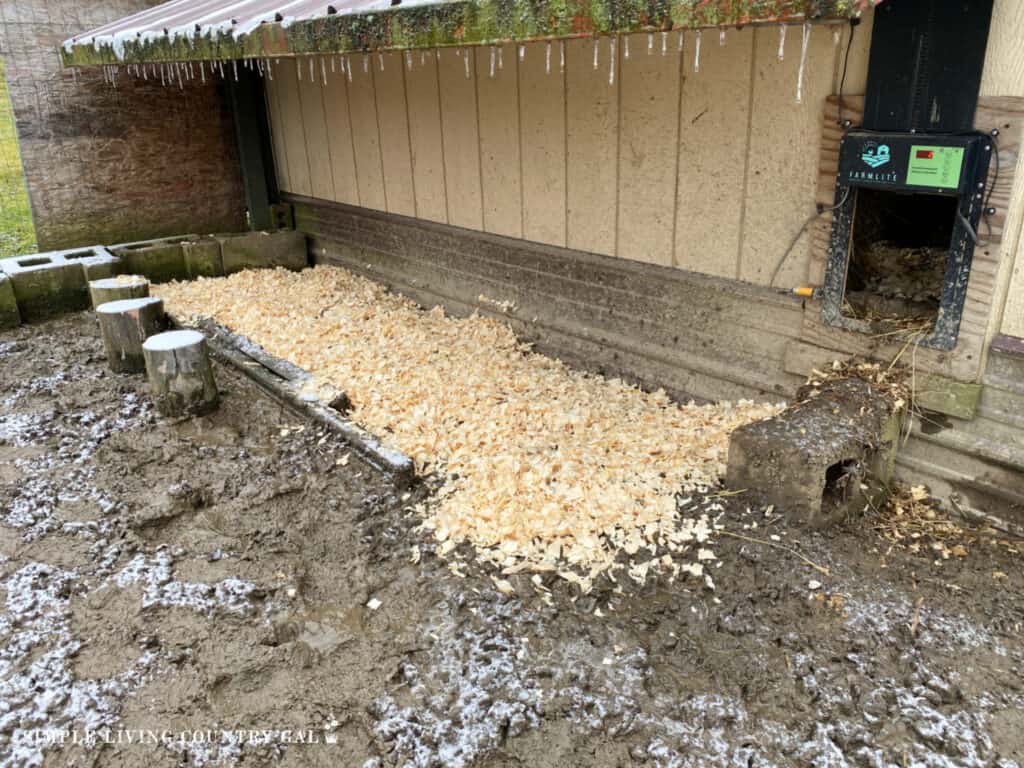
Another option is to place a few logs for your flock to stand on.
Chickens will use these as perches and stand on them throughout the day. Logs are more of a long-term fix as they can stay in the run all year round.
You can also use rocks, cinderblocks, logs, or planks of wood.
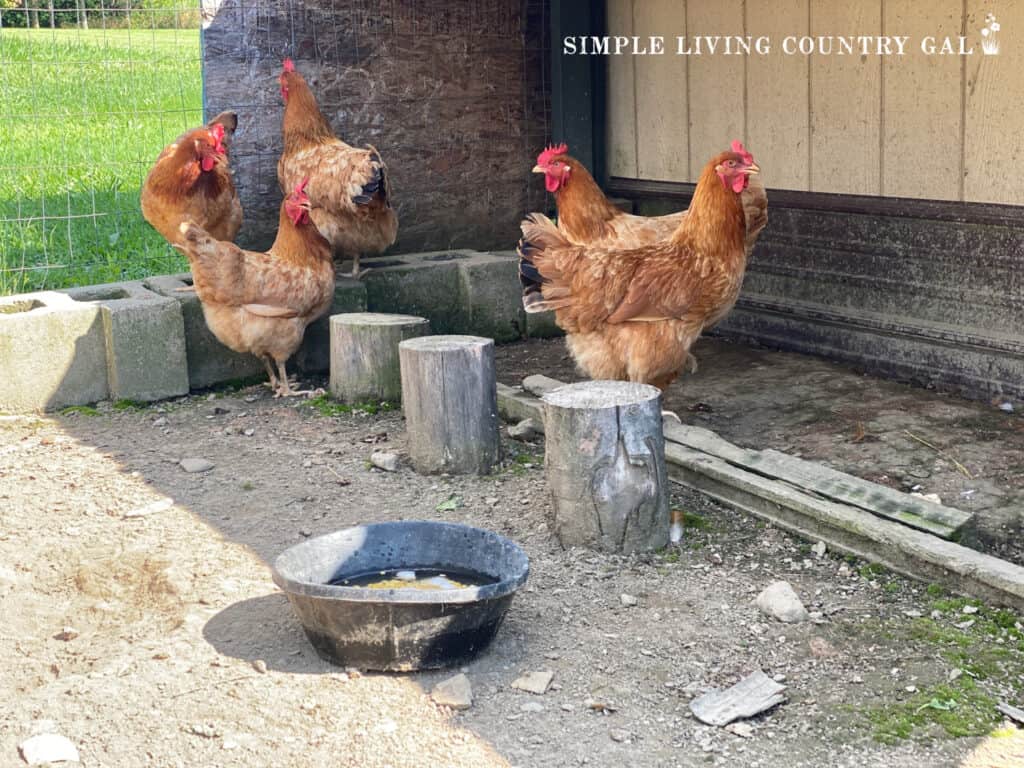
Option #2. Make a Move
In particularly wet seasons, sometimes I have found that no amount of fixing will help other than letting the ground dry up on its own. That is when I will move my entire flock to a dry spot using a portable fence to keep them contained.
I have several portable electric nettings that are great for this. I can move the hens anywhere I need them to be, and they love the change of scenery, as their run gets a well-deserved rest.
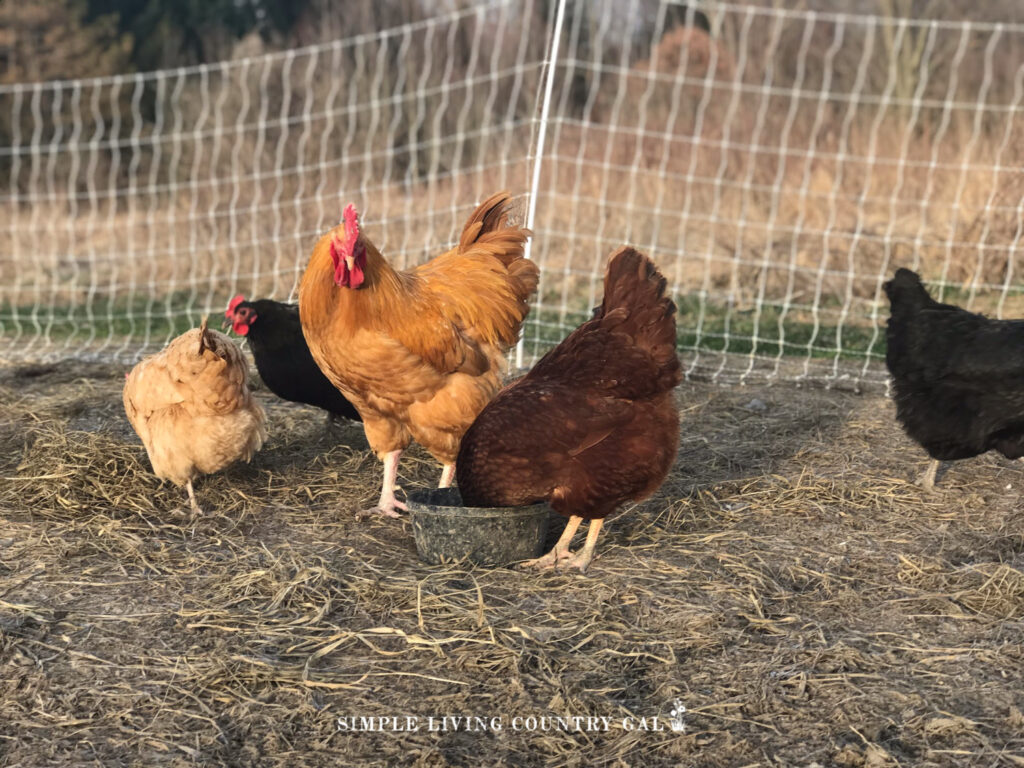
You can see how we use a temporary chicken run throughout the year for more tips on this helpful tip.
Option #3. Use straw or hay Bales
If you have an extra bale or two of straw or hay, you can put a few of them into your wet chicken run as is. Your chickens will climb on top of them often as they love to be up high, even in the run outside.
Usually, within a few weeks, the wear and tear from the flock will tear the bale apart, and they will get busy working it into the ground. Where we live, straw and hay are pretty affordable, just $3-$5 a bale, so, for us, it’s an inexpensive alternative.
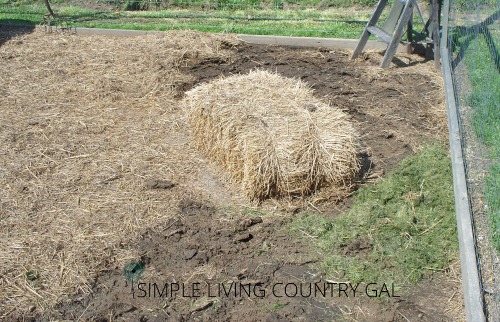
SLCG Pro Tip: Be sure to remove the strings as your chickens begin breaking down the bale.
Option #4. Get your chickens up off the ground
You can add a few platforms or perches in your run to help your chickens get up and out of the mud. Remember, your goal is to keep your chickens dry and clean, and by adding dry options, you will help them stay healthy.
A few ideas are:
- Tires
- Step ladder
- Cinder blocks
- Wood planks
- Pallets
- Logs
If you have metal fencing, you can put a wood plank through a corner to make a perch that your chickens may use throughout the day.
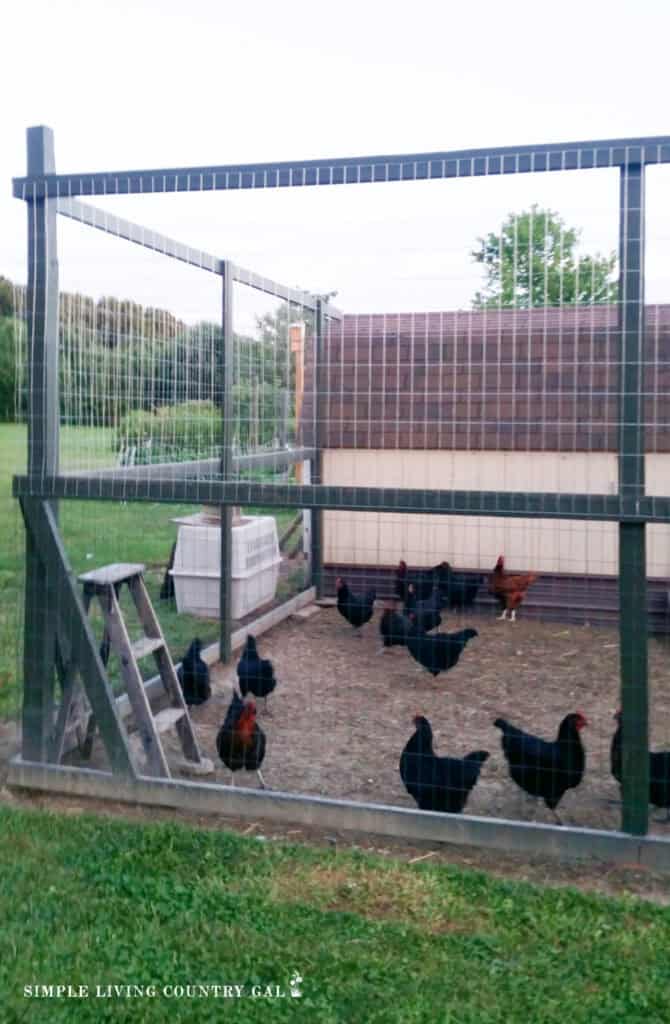
Option #5. Build a buffer from the rain
If things are continuously wet where you live, you can build a temporary roof to help dry a patch out. The quickest and easiest way to do this is with a heavy-duty tarp. Over the years, I have used tarps to keep the rain and snow away from an area in our run, which has worked quite well.
Be sure to use a heavy-duty tarp so it will withstand the entire season before it begins to tear and shred. When installing a tarp, you will want to set it at an angle, allowing any water or snow to run off more easily.
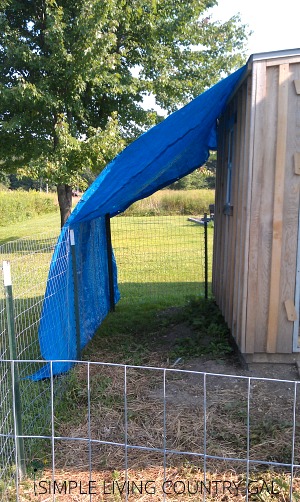
How to Make a Tarp Shelter in a Chicken Run
Step #1. Place a spare piece of wood over the top of the tarp and nail it to the shelter. The wood will help keep the tarp from tearing in heavy winds.
Step #2. Use zip ties to attach the other end of the tarp to any fencing nearby to keep the wind from pulling it up off the ground.
Step #3. Finally, use stakes or bricks at the bottom of the tarp to anchor it more securely keeping it from blowing up.
Option #6. Build an overhang
If you have the tools and supplies, you can also build a small roof off the side of the coop. This added shelter is a great way to keep a dry spot throughout the entire year. Not only in the spring but in winter as well.
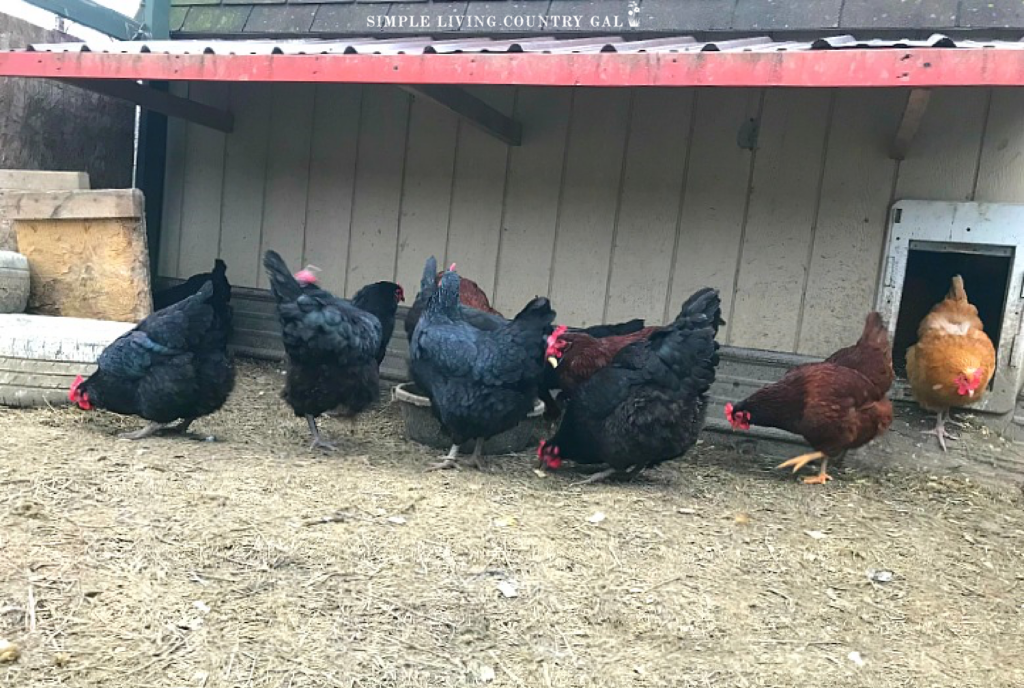
We constructed this roof using scrap metal roofing and extra wood that was leftover from another project.
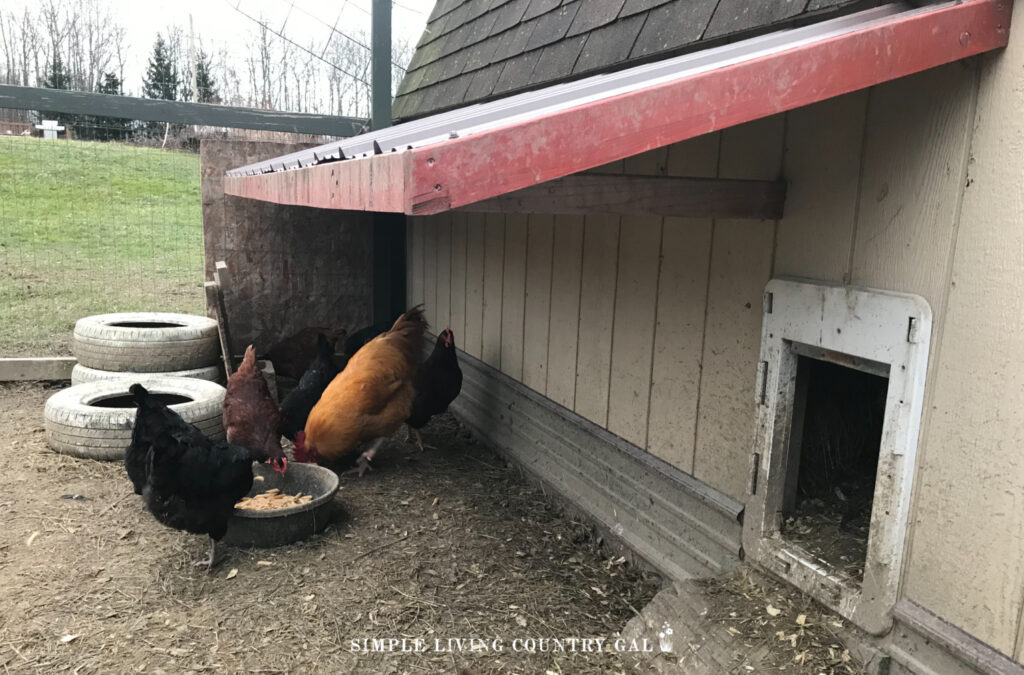
A small wooden board at one end stops the wind from coming in, giving a nice dry area in an otherwise messy and muddy chicken run.
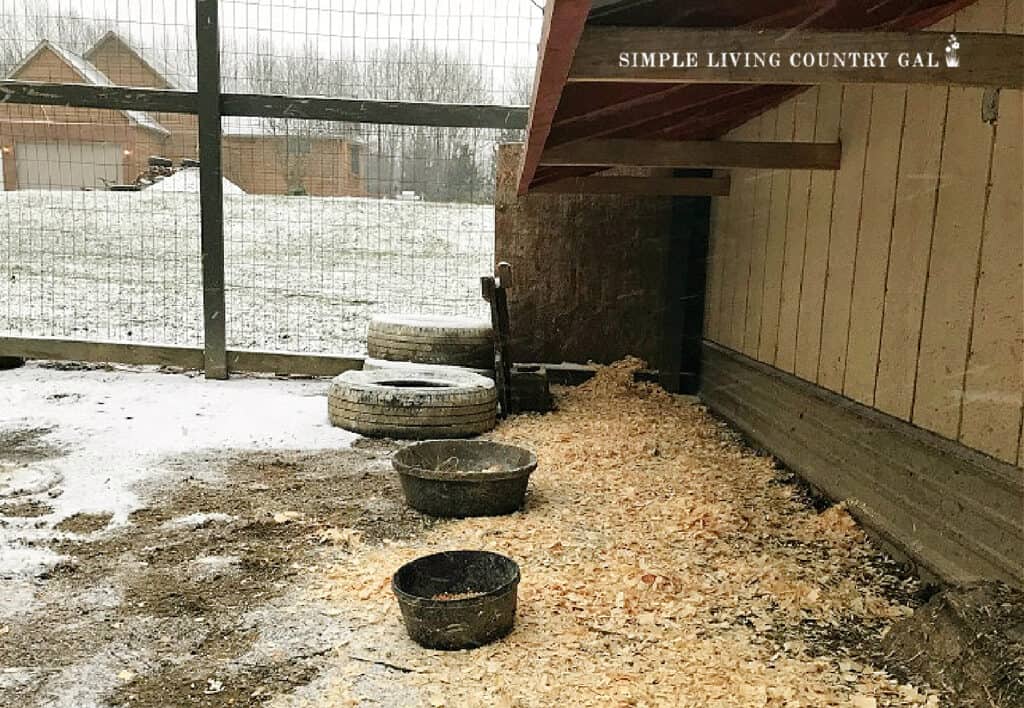
When homesteading, it is important to think outside of the box. Look at the situation from all sides and see what you can come up with using supplies you already have on hand. Remember, it doesn’t have to be pretty, although that is nice, just effective, and you may be surprised at how well an idea of yours will work out.
When dealing with a situation such as a wet chicken run, look at the tools and supplies you have all around you and think creatively about how to resolve a problem. I love the challenge of making something out of nothing and see this as an essential homesteading skill.
Discarded hay? Random cinder block? Extra cut logs? Instead, see it as a solution for your soggy and wet chicken run so you can continue to raise chickens that are healthy and happy.
More Chicken Care Resources:
- Keep Chickens Warm Without Electricity
- Signs Your Chicken is Sick
- How to Turn an Old Shed Into a New Coop
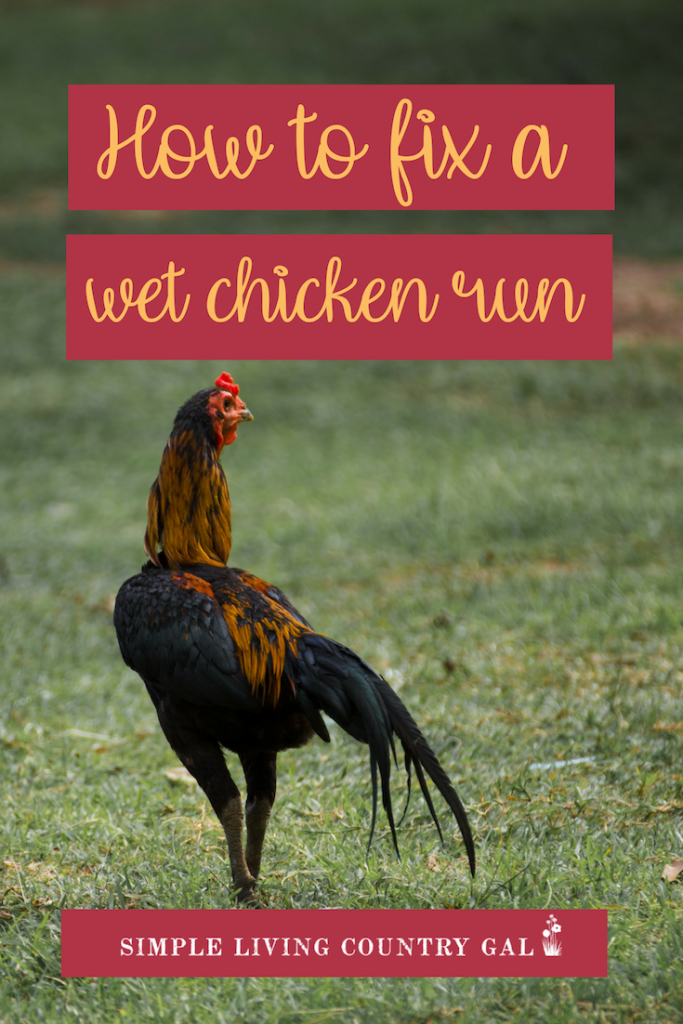

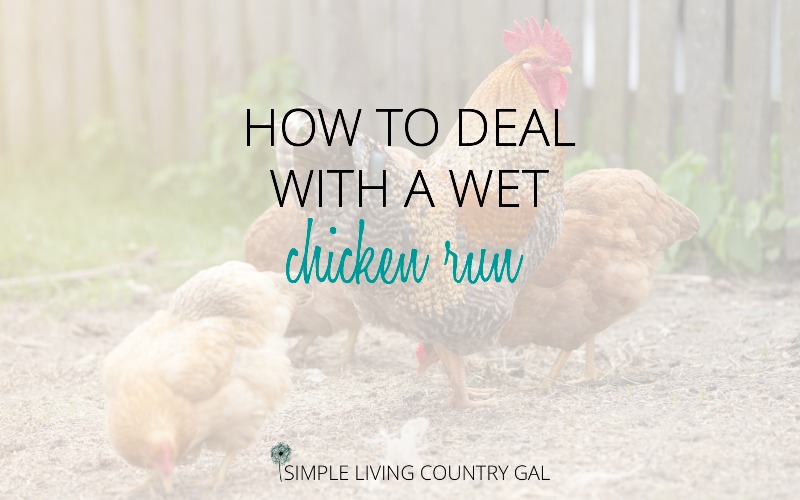
A muddy yard was my biggest chicken raising nightmare until I discovered pine pellets, available from any local feed store. They are super cheap! I think I pay only $8 per 40# bag. Pine pellets are not the same as pine shavings. They are shredded pine that is compressed into pellet form. I do mix them with shavings by pouring a couple of bags of each onto the most drenched, muddy areas of the yard. Within 24 hours most of the puddles get soaked up by the pellets. As the pellets soak up the moisture, they first expand (like a sponge) and then gently fall apart so what you wind up with is a soft, fluffy floor of pine sawdust. The chickens won’t eat it, it’s perfectly safe. They are a lifesaver for a muddy run/yard!
Hi Kristine,
That is a great idea, I have not sued pine pellets before. I am usually not one to purchase anything unless we absolutely have to, but maybe if they are super cheap 🙂 I will give them a try. Thanks for sharing!
I was on a poultry conference the other day where they specifically warned us against using sawdust (not pellets) because it’s know to cause respiratory issues in chickens.
Yes, you are exactly correct, that is why I do not recommend using sawdust.
You have some interesting ideas. The reason I don’t do this for my chickens, however, is because this can result in mold and mildew which in turn can cause respiratory issues for my chickens. Instead, I pre-planned runs (they have 4) around the coop that I rotate them on every 3 months. When this design was built in built the coop and runs on higher ground so there would be no standing water. It gets really wet in Louisiana so I’m always looking for new ideas. After 10 years with chickens I’ve decided the design I currently works the best for my situation.
Hello Kit,
I absolutely agree, my methods are probably only useful in damp conditions rather than overly wet like your state is. During very rainy periods I do have to go out and remove any hay that may be rotting rather than decomposing.
I just love the setup you have for your flock, what a great idea!
Have a great day,
Tracy Lynn
I have a corral and i use it now for ducks and chickens it was mucky, muddy. I had those people that cut the tree limbs along the road and around power lines, dump a load of their shredded chips in the corral. I had a few goats in there at the time and left it mostly in s mound but scatter some around with a silage fork. They liked to climb on the mound but then a year or so I put the ducks and chickens in there. They love that mulch, they have dug in it and scattered it all over the corral, its really breaking down to awesome potting soil, mulch, etc. I scatter hay or straw on it periodically for them to scratch arpund and eat what goodies they find in it, but they still dig deep into the dark mulch and find grubs and such and also they make a hollow to sit in.
Thank you for your helpful info. We have been fighting a wet chicken run all winter. Today we put down hay that we had for our horse. Seems a to be working so far. BTW my 11 Hens and one roosters were scared of the hay when we first added it. They hid in the coop for a while, we got them to come out by putting some scratch on the ramp that goes into the coop. It was enough to lure them back to the run. We also added a tarp to the top of the run to keep it dryer. No more walking in an inch of mud and poop for my girls and guy. I’m sure we will have to add more in a few days but it is so much better at this point!!
So, glad you found it helpful Loretta!
Just be warned, you will need to remove that straw and hay come spring and it’s not easy. So only add what you absolutely need to.
Stay dry!
Tracy Lynn
I always use egg yolk thinned with a bit of water carefully fed with eyedropper. Carefully clean beak after each feeding. Keep it warm and preferably put one other chick in with it that is eating on its own. This gives it company, warmth and it will start to eat on its own faster watching the healthy chick eat.
This is a great tip, thank you for sharing!
I loved reading your article; it was really informational. I hope to see more in the coming days.